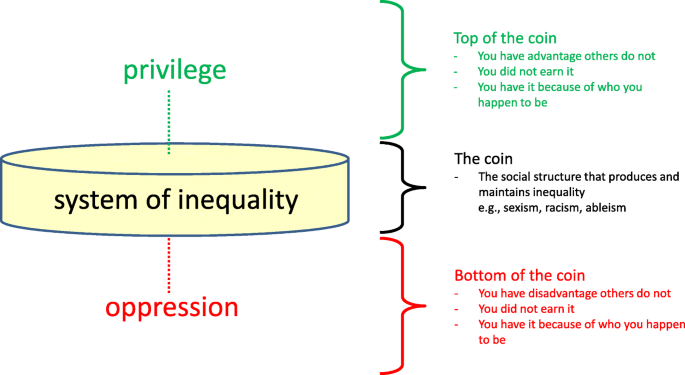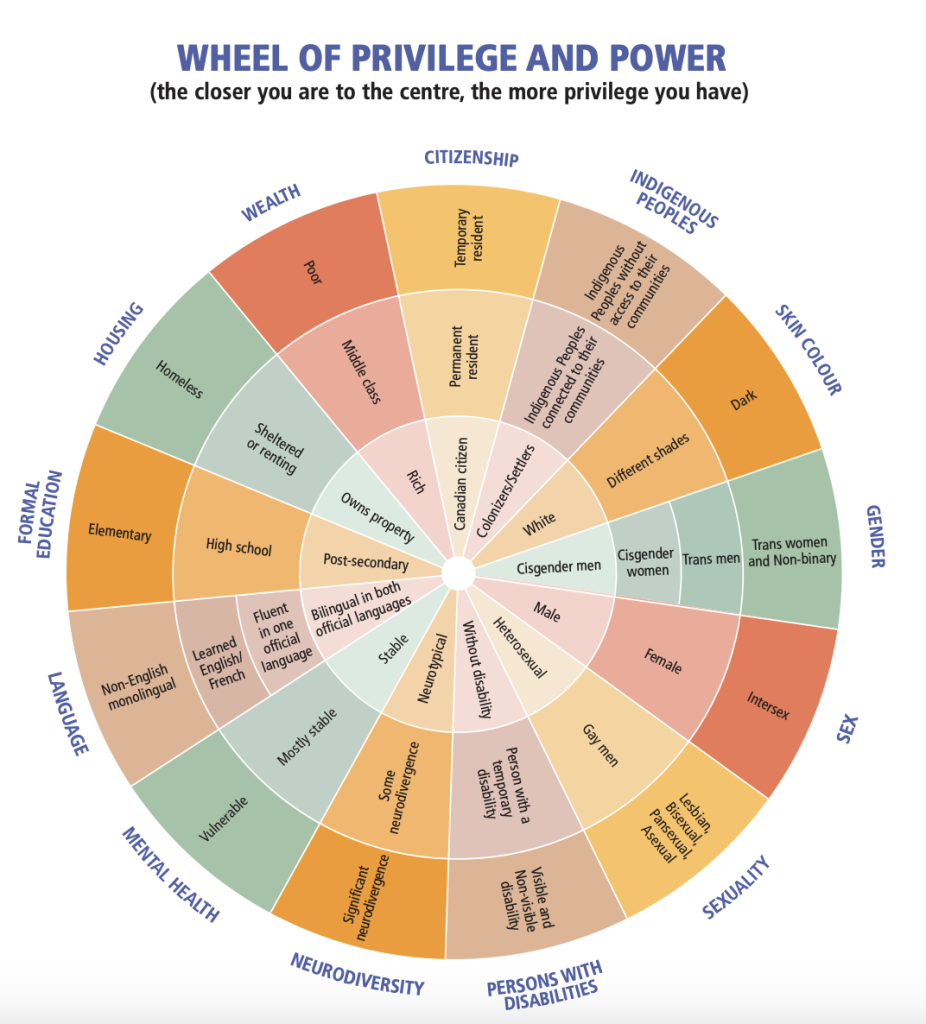3 Equity Deserving Groups
Who are these equity deserving communities?
“Equity deserving groups are communities that experience significant collective barriers in participating in society. This could include attitudinal, historic, social and environmental barriers based on age, ethnicity, disability, economic status, gender, nationality, race, sexual orientation and transgender status, etc. Equity-seeking groups are those that identify barriers to equal access, opportunities and resources due to disadvantage and discrimination and actively seek social justice and reparation.”
Canada designates equity-deserving groups based on the historical and current harms these groups experience (Government of Canada, 2022). The groups include:
- women
- 2SLGBTQI+
- newcomers
- persons with disabilities
- Indigenous people, and
- racialized individuals
The Coin Model of Privilege and Critical Allyship
Below is a framework a framework designed to address privilege and its connection to health disparities. The model uses the metaphor of “coins” to symbolize various systems of inequality, such as racism and ableism, which provide unearned advantages (privilege) to some and unearned disadvantages (oppression) to others. It argues that focusing solely on marginalized groups when discussing health equity overlooks the role of privilege and limits potential solutions.

For further reading on the model and its implications: The coin model of privilege and critical allyship: Implications for health
What are the structural barriers facing communities?
One way to think about equity-deserving groups is to consider the Wheel of Power and Privilege introduced in the previous section. Equity deserving groups experience collective barriers, lack of access, and, in other words, less power and privilege in our society. People who are further from the centre of the wheel depicted above may be seeking equity, social justice, and reparations.
Equity deserving groups experience collective barriers, lack of access, and, in other words, less power and privilege in our society. People who are further from the centre of the wheel depicted above may be seeking equity, social justice, and reparations.
There are barriers that equity-deserving groups face in the collective pursuit of equity, social justice, and reparations. Below, we highlight some of these barriers to help build understanding and personal reflection on how we can remove barriers in our personal and professional lives.
Epistemic Injustice
The video below describes epistemic injustice, the contributing factors, and examples of how this creates harm and inequity for equity-deserving groups.
Historical and Ongoing Harms
To embrace our positionality and reflect on how we fit into the broader systems of power and privilege, we must undertake the work of understanding historical and ongoing harms that equity-deserving groups face. These harms take many different forms. Please see below for some examples.
CONTENT WARNING: Depending on your lived experiences and identities, some of the content on this site may be troubling, uncomfortable, challenging, and, at times, triggering. Engage mindfully and intentionally when embarking on your exploration of equity-based co-creation, and connect with available resources as needed. We have also included a list of support resources below.
- Canadian Mental Health Association (CMHA): Offers programs and resources for Indigenous peoples, LGBTQ+ individuals, immigrants, refugees, and racialized communities.
- 1-833-456-4566 (24/7)
- CMHA General Website
- CMHA Website Specifically for Indigenous Groups
- Centre for Addiction and Mental Health (CAMH): Provides services and resources tailored to marginalized groups, focusing on cultural competence in mental health care.
- Black Health Alliance: Specifically supports mental health in the Black community.
- Indigenous Services Canada: Provides mental health services respecting the cultural needs and practices of Indigenous communities.
- Egale Canada Resource Page: Focuses on LGBTQ+ mental health, providing resources and support services.
- South Asian Mental Health Alliance (SAMHAA): Offers culturally sensitive mental health support for individuals of South Asian descent.
- Asian Mental Health Collective (AMHC): Provides culturally informed mental health resources for people of Asian descent.
- Muslim Wellness Foundation Canada: Offers mental health resources tailored to the Muslim community.
- Trans Lifeline: Provides crisis support for transgender individuals internationally, including Canada.
- Soch Mental Health: focuses on providing mental health support and resources specifically tailored to the South Asian community.
Take the time to sit with these harms; how does it feel to learn about these historical and ongoing harms? How is this information similar or different from what you may have learned in school or other areas of your life?
Knowledge Checkpoint

